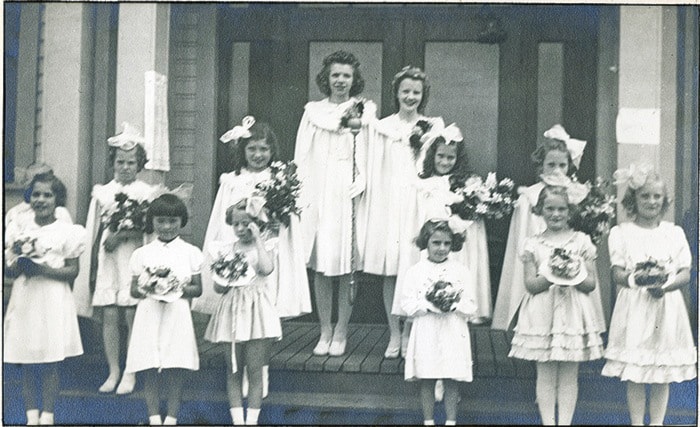Before 1942, the presence of children of Japanese descent in both May Day and Pitt Meadows Day or Strawberry Carnival events was common.
After all, the celebration was all about the crop, fully ripe by the middle of June, and something Japanese Canadian farmers in the community excelled at.
At the first Strawberry Carnival in 1938, three young Japanese Canadians – Kimie Fuji, Yasuko Eyemoto, and Mitsui Suzuki – participated.
In 1939 Kimiko Kubota, now Lillian Shimoda, was a participant along with Elsie Hinatsu and Mary Osaki.
In 1940, Tokiye Kobayashi and Hatsue Hirashima represented the Japanese Canadian community.
In 1941 we don’t have a record of the Royal Party participants, but this Pitt Meadows Day, if it took place, would have been less than six months before the bombing of Pearl Harbor and the ensuing removal of Japanese Canadians from the coast, leaving Kimie Nagamatsu the last Pitt Meadows child of Japanese descent to participate for generations to come.
Seventy-three years ago in Pitt Meadows, 11-year-old Lena Takatsu and her family walked onto a yellow school bus that carried them from their home on Ford Road to the CPR station in Maple Ridge. All they had were the eight suitcases they were allowed to bring. They were among the first Japanese Canadians in the Fraser Valley to leave the only home they knew in Canada and went on an exodus across the Rockies to the Prairies.
The Japanese Canadians moved to Pitt Meadows around the beginning of the 20th Century. The land shortage in Japan drove them to Canada in search of idyllic homes for their families to settle permanently.
The Japanese Canadians lived arduous lives just like other pioneers in Pitt Meadows. While some rented lands to farm, many rented equipment and reclaimed lands along the Fraser River that are still being farmed today.
Most Japanese Canadians farmed raspberry, strawberry, and blueberry, along with radishes and cabbages on their farms. Because of the language barriers, however, they formed their own co-op and sold their produce to Powell Street, the former Japanese area of Vancouver.
Meanwhile, Japanese children in Pitt Meadows attended the small public school that used to be on Harris and Advent roads. They played alongside their Canadian peers and helped their parents in the fields almost every day.
Two to three times a week, after regular school hours, they learned Japanese by attending Japanese School Japanese Canadian Hall on Advent Road.
Nevertheless, life on Manitoban sugar beet farms was a harsh turn for the Japanese Canadians. After week-long train rides in crammed rail cars, Japanese Canadians from Pitt Meadows were pooled into the immigration hall in Winnipeg, where sugar beet farmers picked the families they wanted to host.
Families with able-bodied men were preferred and families with children had to wait for days until they were paired with their farmers.
According to Lillian Shimoda (nee Kimiko Kubota), who left Pitt Meadows in fourth grade, sugar beet farming was a drastic transition for the Japanese farmers.
In one of Pitt Meadows Museum’s oral history podcasts, she recounted how her parents had to harvest the sugar beets from frozen grounds and ended up having frostbite all over their hands.
Racial prejudice also arose in Manitoba against the Japanese Canadians as they were labeled as “unwanted” due to their resettlement.
The Japanese Canadians were also not allowed to visit large cities such as Winnipeg without a special permit because they were considered “a threat.”
Even after the war, Lillian Shimoda still experienced difficulty finding a job because of her heritage.
Nowadays, most Japanese Canadians who left Pitt Meadows as children now live in Toronto, Winnipeg, and parts of Vancouver.
As their farms were liquidated immediately after their departure, none could return to Pitt Meadows after the Second World War.
With the 75th anniversary of Pitt Meadows Day on Saturday, June 4, we should still remember the Japanese Canadian community that once thrived on this land.
– By Mark Chen, an assistant at Pitt Meadows Museum.
At the museum
The Pitt Meadows Museum’s two sites are open from 10 a.m. through 4 p.m. on Pitt Meadows Day, Saturday, June 4.
It will be celebrating two big birthdays – Miss Pitt Meadows 75th and Queen Elizabeth’s 90th, and there will be birthday cake.
See the “Happy Birthday Queen Elizabeth” exhibit at the General Store and take some time to sign the jumbo birthday card to her.
A “Happy Birthday to the Two Queens” cake will be served at 2 p.m. and there will e a “make your own crown” craft for children and for the young at heart.
Information will also be available on the 21st season of the museum’s popular Heritage Thursdays for Children summer afternoon camp.
If you didn’t have time, visit the “From Home to the Front.”
At the Hoffmann, the artistic blacksmith will ne on hand.
Candy bags will also be for sale during the parade.
Royal Party
Pitt Meadows Day Royal Party 2016:
• Miss Pitt Meadows 2016 Audrey Dougan;
• 1st Attendant Robynn Reid;
• 2nd Attendant Marley Maxwell;
• 3rd Attendant Taryn Hoffman;
• Record Bearer Mackayla Grocott;
• Medallion Bearer Tabbitha Lepitre;
• Flag Bearers Avrim Hoffman;
• Andrew Rittich;
• Flower Girls – Elizabeth Murden;
• Sophia Fraser;
• Lauren Kania;
• Kayley Ballinger;
• Giulia Reale;
• Jae-Lynn Adams;
• Shuger Klodt;
• Sadie Collett;
• Sophia Woycheshen;
• Mackenzie Luniw.
Retiring Miss Pitt Meadows 2015 is Kyla Malone.
The 1st Attendant was Jillian Severinski, with Attendant Isabella Robinson and 3rd Attendant Kai Ramsay.
